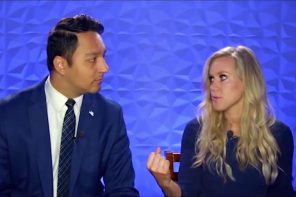To most students of gospel music, Anthony Heilbut’s name is almost as legendary as many of the gospel performers he has chronicled as a writer and recorded as a music producer in his long career. Among his most notable contributions, he wrote the first serious history of black gospel in 1971, The Gospel Sound, and produced a series of well-received records by many of gospel’s golden-age luminaries.
Heilbut’s new book, The Fan Who Knew Too Much: Aretha Franklin, the Rise of the Soap Opera, Children of the Gospel Church, and Other Meditations is, as the subtitle suggests, an extended reflection on a life spent being a fan nonpareil. Not all the essays are about gospel, but the gospel chapters are the book’s emotional center. An abiding concern for Heilbut in these pages is the place of what he called back in 1971 the gospel homosexual—better known as “the children,” in the parlance—within the black gospel world.
Most insiders to this world are privy to the open secret of gospel’s deep reliance on the contributions and influence of gay men and women. But Heilbut opens wide the closet doors and peers in with the bright light of righteous outrage for the plight of the children in an increasingly homophobic religious culture, while also bringing a deeply felt sensitivity for the stories of the children and their musical sensibility. As he writes: “It is impossible to understand the story of black America without foregrounding the experiences of the gay men of gospel.”
Recently, Heilbut took some time to talk with me about his new book and the intersecting themes of sexuality, religion, and the black church’s conflicted relationship to the children of gospel music. What follows is an edited transcript of that conversation.
In the book you show how sexual and gender identity (ascribed or professed) was related to musical performance during gospel’s golden age in the mid-twentieth century. Was that specific to that period? Do you think that looking at non-heterosexual identities might help in reading the history of earlier forms of black American song, such as spirituals?
Absolutely. Absolutely. I mention in the book that when Marian Anderson began traveling, her first musician was the top church pianist in Philadelphia. And shortly after they started touring he was arrested for the same old reasons that put so many others in jail: soliciting. And this would have been in the early part of the twentieth century.
George Washington Carver, who is considered an absolute legend and who was a gay man, was also Marian Anderson’s greatest fan, or so identified. So we’re talking about evidence from the early twentieth century that the people surrounding the church and in love with church singers—their greatest fans—were gay men. We don’t know too much about the nineteenth century because people didn’t seem to ask these questions. But all the evidence I have is that as long as there have been records or reports of black religious singing, gay men played a very active role either as performers or as managers, as conductors, as accompanists, as directors.
So in that light, when you talk about musical performance style as expressing gay identity or experience, do you think the performance confirms the gay identity or contributes to it?
Gospel fans as I’ve known them tend to have a fairly low level of consciousness [about issues of sexuality and identity]. Even the younger people have been somewhat untouched by gay liberation, to the extent that they still use words like “sissy” and “bulldagger.” Gospel for the children is a way of life, and somehow it runs down one track and their sexual identity runs parallel. How they imbricate is a big question.
That’s interesting, this question of knowledge, because what underpins almost any discussion of gayness in gospel music is the simultaneous operation of different kinds of knowledge: there’s orthodox or official knowledge (what people claim to know); privileged knowledge (a few really know and talk privately); tacit knowledge (unspoken but widely observed); and then there’s knowledge that’s normatively denied—what might be called operational lies, if you will, like the president of Iran saying there are no homosexuals in his country.
I think that among your categories, tacit and privileged knowledge, you really hit it. The kind of reflective, intellectual approach that you might find in a James Baldwin, or that you even find in a Jim Swilley, the white Pentecostal who indicates that he always knew he loved the Lord and he always knew he was homosexual—but that’s already a kind of highbrow self-consciousness that I tend not to find among gospel singers, certainly not among the older ones. I’ve found many other things, you know. But a more modern consciousness, I didn’t find.
Your account of the black church charts a dramatic swing in attitudes and practices toward non-heterosexuals over the past 30 years. What do you think are some of the origins of this shift?
I connect the extreme homophobia in the black church of the last twenty-five to thirty years to the intrusion of particular right-wing elements within our culture. I don’t want to say these are exclusively white because unfortunately there is a long tradition of reactionary tendencies within the black church.
But there are a whole bunch of famous white evangelists, among them Kenneth Hagin and John Hagee, who are promulgating this “prosperity gospel.” “Name it and claim it,” which of course is extremely quietist politically, because essentially you don’t have to do anything. You don’t have to organize. You certainly don’t have to think in large sociological categories. It’s all based pretty much on “what you tithe will be reflected in the Lord’s generosity.”
And always the two major themes of Pentecostals, and more particularly black Pentecostal churches (and the larger they are, the worse it gets) emphasize two themes: prosperity gospel and opposition to gay rights.
Why do you think that is? Why are those two joined? Because it’s not obvious that one necessarily has to be linked with the other. Is it an underlying straight assumption about wealth as a sign of masculine virility?
Oh, that’s an excellent idea… I have two theories: One is the great dialectic in American culture between Jesus the meek and humble lamb and Jesus the warrior, the man’s man. In other words, is it the Jesus who appeals to the effeminate preachers and their female flock or the Billy Sunday-Billy Graham [version represented today by] Tony Evans? He is this black football-playing advisor to the Promise Keepers, and they stress that they’re excessively butch. In fact, one of my more playful lines is that muscular Christianity devolves into the image of Bishop Eddie L. Long posing on his smartphone.
In recent gospel, [the trend has been toward] the most outrageously secular performers. They do all kinds of things that are smack out of hip-hop or rap, much less R&B. But at the same time, they are exceptionally pious. Like a man named Tye Tribbett. On the one hand, he’s doing stuff that’s just ready for Hot 40 radio, and on the other, he’s very moralistic. And if you’re going to be very moralistic, who is the easiest target to come by? In other words, how do you justify your extreme materialism but by showing how spiritual you are? And how do you show you’re spiritual? By giving up a very obvious sin. And for some reason they decided to pick on the children. That was the sin that was worse than all the others…
So I agree with you, it’s not a logical connection, but it seems to be the connection that was made. And (I’m generalizing here) there is no megachurch that I know of that doesn’t also go after the sissies.
President Obama’s recent public endorsement of same-sex marriage generated a range of responses from black church leaders and congregations. Have you seen similarly varied responses within the world of gospel music?
Oh, I wish so, but I think it’s absolutely irrelevant. I’m sure you’ve seen the beautiful statement by Rev. Otis W. Moss III in Chicago (he took over Jeremiah Wright’s position). Even better, I have a friend, a great gay activist, who sent me a clip of some fellow from Texas who was the real deal. He could grunt and groan. He said [apropos religious objections to homosexuality], “You all are majoring in what Jesus minored in.” I love that. I love that. That was really talking church talk…
But these are exceptions. The thing is, it’s the megachurches—it’s the big sanctified churches, it’s the 20,000, 50,000 church congregations [that are anti-gay]. So I just don’t know. I think it’s only to the good, it’s only useful, Obama’s endorsement. But what sway it will have within these churches, I don’t know. I am much less encouraged than everyone else, because I’ve always focused on, as I say, where the people are.
When you consider the longstanding tradition of orthodox religious antipathy toward gay men in particular, what do you think are some of the factors that account for why religious art has inspired and continues to inspire so many gay people?
I’m imagining down the line that I will have to dispute someone or someone will debate me [on this question].
What I want to say to all of these people from all denominations—and we know that homophobia is allowed in all churches—is: where would religious art be without gay men? You wouldn’t have the Sistine Chapel. You wouldn’t have The Last Supper. You wouldn’t have “Ave Maria.” Most likely you wouldn’t have the “Hallelujah Chorus,” because we seem to think Handel was gay.
And if we were to get rid of all of the gospel songs and hymns [written and performed by gays] that people have been saved to…? I mean… [trails off laughing]
In my research for my book I ran across something that composer and critic Virgil Thomson wrote back in the ’20s or ’30s when he did this poor man’s psychoanalysis of a popular hymn book, and by his count, ninety-some of the hundred-odd tunes were, as he classified them, some kind of homoerotic meditation on love for a bleeding and beaten Jesus.
Fascinating, because of his work with Gertrude Stein and fascinating because in 1941 Thomson did a piece on Utah Smith, who is this guitarist whom the white blues boys just love. His big hit was “Give Me Two Wings to Veil My Face.” Of course Thomson was gay yet tolerating nothing, with all kind of Southern bigotry toward blacks and Jews, etc., but he knew the score. And he went to Utah Smith’s church, and he observed how the people were responding and particularly how they would go up and dance in the aisles. And then he noted, as almost no one had before, when they finished dancing they went rather sheepishly back to their seats. He had a wonderful sense of the whole ceremony.
Shannon Williams [a white Pentecostal I write about in the book] had this theory that gay people are attracted to Jesus because Jesus was a hot man. Maybe. Jesus spoke as someone who suffered so much for you, a man in such torment for you, someone who is surrounded by his disciples. I never heard [the children] talk about Jesus and the beloved disciple. That’s more what I’ve heard from white queer theorists. But Jesus as my only friend, as someone who traveled this road before—I could certainly understand how that figure speaks to the oppressed, and particularly why not to gay people and lesbians?
“Writing It Out,” the third section of your first chapter, is one of the more evocative sections of the book. Stylistically, it’s an excursion of sorts, less energized by the urgency with which the book tells the individual stories of gospel’s gayness. It’s more of a jazz riff tracing through-lines of queer experience and expression in modern religious history and literature.
I agree with you, I went on an excursion—but remember that those first two sections of the book are very graphic and very dramatic. I really hoped people would laugh and that people would cry. I’m much cooler in [“Writing It Out”]. I am, even by my standards, unusually impassioned in those first sections.
But you must remember that I’m really very angry. I really want to be literate and literary, but I’m really furious. Probably the most daring thing I say in the book is when I compare [the gospel church to] the Taliban, and then I say, thinking of all the ruined gay lives, this really is the number that no man can number.
It’s also interesting to me that “Writing It Out” is followed by the section “War on the Children.” Such an organization suggests that the latter was a reaction against the former—that as these voices emerge, there’s this really virulent reaction culturally against them.
And also it’s so very political. As the church has become more right-wing or apolitical—and by the way you can’t even blame the church. The whole culture—we are so far post-integration. In other words, we are so back in segregation that maybe it’s asking an awful lot of black gospel people to be more progressive than the dominant society. But the fact is that everything progressive that was represented by [gay men such as Bayard Rustin, James Baldwin, Al Duckett] is being disputed in the church.
The emergence of YouTube figures prominently into the book’s discussion of being a fan. How do you see the role of digital/virtual fan culture in shaping gospel stars’ public images and effecting how much control stars have over those images? And how does the internet effect the politics of the gospel closet?
What’s so good about YouTube is, first of all, it’s an incredible archive of old recordings and performances. But in the case of the gay subject, because people like Tonéx were interviewed on YouTube, there were thousands—tens of thousands of emails [and other responses]—can you use a curse word on Religion Dispatches?
Oh, I think so.
When Cadillac Kennedy did that anti-Eddie Long tape: “Dick-sucking Eddie Long! You’re wrong!” She got over a million views. So what’s coming in are a huge number of statements. Many of them are typically homophobic, “God is not mocked,” “you’re going to hell” and all of that. But there are a great many people saying, “No.” And this is down the line.
A white former Pentecostal wrote about how homophobia ruined his youth. He said he went to Lee College, which is one of the most famous and earliest white Pentecostal colleges. And he said there were gay people everywhere and somehow they were all playing the same game. And somehow they could survive it, but he couldn’t. And so his very moving story is now available on YouTube.
In other words, there is a lot of nonsense, just as there’s a lot nonsense on the web. But this has allowed a forum, particularly in the area of gay gospel, for these artists and a forum for discussion. Thanks to YouTube, more than any other possibility on the web, [sexuality in gospel music] is now in the political arena, it’s out there in the open.
The front page image for this story is of singer Alex Bradford, from the cover of his 1954 hit “Too Close to Heaven.” —Eds.




